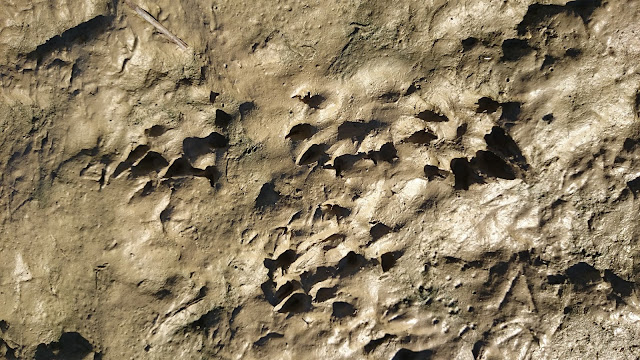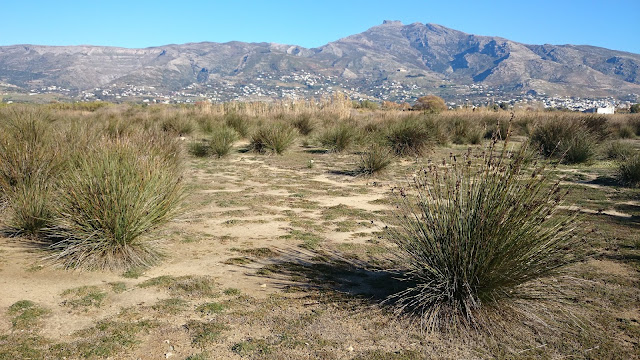 |
| I have been visiting and taking nature notes at Vidra Pond since summer 1984. This is a personal pilgrimage so please excuse the selfie. |
Kampos Karystou Evia (Euboea) Greece
December 23rd 2015
One of my home turf sites is the Plain of Karystos, also known as Kampos Karystou. This is located in the southern part of Euboea Island near the tiny port town of Karystos, where there is a very large Natura 2000 area (part of the EU Natura 2000 ecological network of protected areas). However the Karystos plain is no longer in the Natura 2000 site because it was excluded from the larger area in 1999 after a band of locals black-mailed the Greek government into effectively shrinking the Natura 2000 site in order not to include the then touristically very valuable coastal area. However, paradoxically the nearby Natura 2000 site is still called OROS OCHI - KAMPOS KARYSTOU - POTAMI - AKROTIRIO KAFIREFS - PARAKTIA THALASSIA ZONI (GR2420001). Anyway...
During the late '90s some locals did something unspeakable in their fear and rage against the inlcusion of their private property within the proposed Natura 2000 protected area. They cut over 200 willows lining the mid Rigia stream and dumped a few hundred truck-loads of construction site debris in the coastal wetlands of Rigia and infilled the artificial ponds of Souvala. The foundations of two large buildings were also built in the middle of Rigia Marsh in an effort to prove that the (wet)land is PRIVATE. These acts of sabotage have disfigured the Karysos Plain's best habitat areas quite a bit, but much wetland still exists and it is still a beautiful plain to enjoy a natural history tour. The unique thing about the plain is that it is enriched by high ground water levels and even during a period of prolonged drought there is still much water. This winter local farmers are complaining about the lack of rain-fall and the weather is automn-like. I visited on a day-trip from Athens (Ferry from the port of Rafina to Marmari) and tallied 37 species of birds during the 4 hour survey. I describe the tour here.
 |
| Lala stream river mouth (site 2) just west of Karystos. The landscape is Cycladian almost. |
 |
| Lala stream (at Pigadi Pasa) just before the river mouth (site 1). Near here was the very famous "Disco Vatrachos" in the mid '80s for those who remember... (Appropriete since Vatrachos means Frog). |
 |
| Veiw seaward from Rigia Bridge (site 2). The lowermost part of Rigia has permenant water for about 1000 meters - even during the longest droughts. |
 |
| Rigia river mouth - reed bed. Site 3. |
 |
| Rigia river mouth - a closed estuary lagoon. Site 3. |
 |
| Rigia river mouth and the Rigia marsh (Αλμύρες του Σαραβάνου). Mount Ochi in the Distance. Site 3. |
 |
| What I consider Otter prints in Rigia marsh. Now you really need to have seen a lot to interpret this from these bad photos in very soft mud. Dog and fox prints where also present. Site 3 |
 |
| Otter prints in Rigia marsh. Site 3. Otters are really scarce on the islands of the Aegean. This plain has a tiny isolated population. |
 |
| Otter prints in Rigia marsh. Site 3. I add more shots since i am not 100% sure. I found no spraints anywhere. |
 |
| Glass-worts (probably Salicornia) at Rigia marsh. Sheep trails. Site 3. |
 |
| Mid part of Lala Stream. Site 4. |
 |
| Vidra Pond. Site 5. |
 |
| Mid Rigia. This is another pool in the stream bed and it is intermittent at this area. This part of Rigia was practically logged to degrade the willow wood that existed in the '90s. Site 6. |
 |
| Striped-necked terrapins were really abundant! Amazing for a winter day. Site 6. Since these photos are taken with my Sony Z1 cell phone I cannot not get close-ups. They are wary and I have found parts of them in otter spraints in the past. |
 |
| Souvala Pond (what's left of it after extensive in-filling). Chaste trees all around. Smoldering burnt rush meadows in foreground. Shepherds burn the Juncus acutus in the winter. Site 7. |
 |
| Dead pond terrapin killed by burning of the rush meadows. Site 7. |
 |
| Intermittent upper part of the Rigia stream. Its almost like a wadi. Tree frogs were croaking here and during the long scorching summer it is usually totally dry. The chaste tree bushes are great reptile habitat refuges.The area is heavily grazed here. Site 8. |
 |
| Unusual eutrophication in one of the pools in the intermittent part of the upper Rigia stream. Perhaps untreated waste is dumped here - this is a common event in many agro-pastoral plains. Several frogs were active .Site 9. |
 |
| Rush beds (dominated by Juncus acutus) and open wet meadow habitat north of the bridge of Rigia. Its a very very dry winter, you can tell here. Usually frequent winter rains flood these habitats. They are heavily grazed. Site 2. |
2018 - UPDATE
For anyone interested in the conservation prospects of this site WWF-GREECE has published an article on this at: wwf.gr:oi-ygrotopoi-toy-kampoy-karystoy.
The article by Nikos Georgiadis refers to the extent of the wetland thata has been in-filled by construction-site debris and other trash in the last year (bright green delineations below). The wetland areas are delineated in red and given codes on this helpful map also.
 |
| Map courtesy of WWF-GREECE showing the three wetland units of the Kampos Karystou (Karystos Plain Wetland). |




